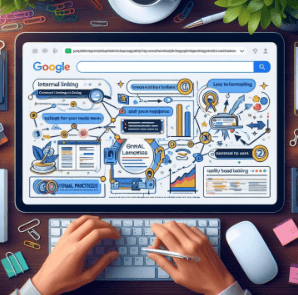The Power of Internal Linking: Boosting Your Site’s SEO and User Engagement

Introduction: The Unsung Hero of SEO
When it comes to SEO Outsource SEO, the discussion frequently rotates around outside factors—backlinks, keywords, and content quality. Whereas these components are vital, there’s another, regularly neglected, technique that plays a critical part in improving a website’s SEO execution and client engagement: inner connecting. Inner joins are the hyperlinks that interface one page of your site to another, making a web of content that’s both safe for clients and indexable for look motors. This basic however capable strategy can make a considerable distinction in how your location performs in look comes about, how users interact along with your content, and how viably you direct guests through your site.
The SEO Benefits of Internal Linking
Inside connecting is more than fair a navigational help; it’s a imperative component of your website’s SEO methodology. When look motors slither your site, they take after the inside joins to find and record the pages inside your location. The structure of these links tells search motors which pages are most critical, making a difference to set up a clear chain of command of content. To optimize this process, consider consulting an SEO expert for guidance on best practices.
By deliberately setting inside joins all through your location, you’ll convey connect value (the esteem passed from one page to another by means of joins) more equitably over your site. This makes a difference guarantee that imperative pages, such as foundation content or high-converting landing pages, get the consideration they merit from look motors. Furthermore, inner joins can improve the pertinence of a page by partner it with particular keywords, subsequently making strides its chances of positioning higher in look comes about.
In addition, inside connecting makes a difference in lessening the bounce rate—a metric that indicates the rate of guests who take off your location after seeing as it were one page. By directing clients to related content, you energize them to investigate more of your location, expanding the time they spend on it and signaling to look motors that your location gives profitable and locks in content.
Enhancing User Experience with Internal Links
Whereas SEO benefits are critical, inner connecting too plays a pivotal part in upgrading the client involvement. A well-structured inner connecting framework makes a consistent travel for clients as they explore through your content. When guests can effortlessly discover related articles, item pages, or administrations without having to search extensively, their by and large involvement on your location progresses.
Internal links serve as a roadmap that guides users to additional information, helping them dig deeper into topics of interest. For example, a blog post about the benefits of organic skincare can link to a product page where users can purchase the items discussed. This not only keeps users on your site longer but also increases the likelihood of conversions.
Furthermore, internal links can also be used to highlight older content that remains relevant. By linking to evergreen posts or pages that still provide value, you can keep that content in circulation and ensure it continues to attract traffic. This approach not only maximizes the value of your existing content but also provides a richer, more informative experience for users.
Boosting Engagement and Conversion Rates
Internal linking doesn’t just help with SEO and navigation; it’s also a powerful tool for boosting user engagement and conversion rates. By directing users to related content, you can increase their involvement with your site, encouraging them to explore more pages, read additional articles, or view more products.
For instance, a visitor reading a blog post about the benefits of a particular product can be directed to customer reviews, detailed usage guides, or even to a shopping cart where they can make a purchase. Each of these links serves a purpose: to keep the user engaged and guide them closer to taking action, whether that’s signing up for a newsletter, downloading an eBook, or completing a purchase.
Internal linking also allows you to create a logical flow of content, leading users through a funnel that aligns with their interests and needs. This personalized journey not only enhances the user experience but also increases the chances of conversion. By strategically placing links to high-converting pages within your content, you can subtly guide users toward actions that benefit your business.
Best Practices for Effective Internal Linking
To fully leverage the power of internal linking, it’s essential to follow best practices that ensure your links are both user-friendly and SEO-effective. First, focus on relevance; links should connect related content in a way that feels natural to the user. Avoid overstuffing pages with links, as this can overwhelm users and dilute the SEO value of each link.
Anchor text—the clickable text in a hyperlink—is also crucial. It should be descriptive and relevant to the linked page, providing both users and search engines with clear context about the destination. Instead of generic phrases like “click here,” use specific terms that accurately describe the linked content.
Additionally, regularly audit your internal links to ensure they’re up-to-date and functioning properly. Broken links can frustrate users and harm your SEO, so it’s important to maintain a clean and functional linking structure.
Conclusion: The Strategic Advantage of Internal Linking
In the realm of digital marketing, internal linking is often an underutilized yet highly effective strategy. By enhancing SEO, improving user experience, and boosting engagement and conversion rates, internal linking offers a multifaceted approach to optimizing your website. As you continue to develop your site’s content and structure, consider the strategic placement of internal links as a critical element of your overall strategy. In doing so, you’ll not only improve your site’s performance in search results but also create a more engaging and user-friendly experience that drives long-term success.






